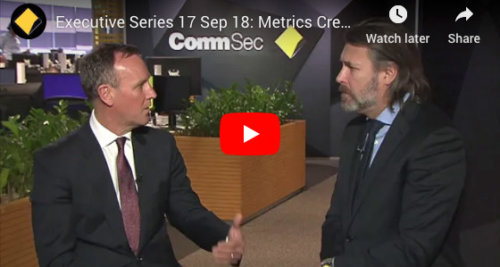Q&A with Graham McNamara, Managing Partner & Member of the Investment Committee
Graham has more than four decades of experience in banking, funds management and financial markets. Before cofounding Metrics, he established the loan syndications and agency businesses at major Australian banks.
Where did you grow up, and what was it like?
I’m originally a New Zealander. I grew up in Invercargill in the South Island. Its claim to fame is that it is one of the southern most cities in the world, so it was cold, wet and windy! Like a lot of New Zealanders, I left in my early 20’s and moved to Australia. My first job here was in Melbourne with Bank of New Zealand.
Tell us how you came to be a founding partner of Metrics.
Justin Hynes, Andrew Lockhart and I worked together at NAB, and as a result of increasing bank regulation following the GFC, we saw the opportunity to establish a funds management business specialising in providing funding to Australian Corporate borrowers and projects. At the time, this asset class wasn’t available to retail investors in Australia other than via investing in bank equities. In 2013, we left NAB and launched our first fund, the Metrics Credit Partners Diversified Australian Senior Loan Fund with our first Wholesale investor. In 2015, we were joined by our fourth partner, Andrew Tremain. Metrics has since grown to offer more than a dozen funds and manage AUM of more than $6.1 billion.
What interests you about corporate lending?
I’ve been involved in corporate lending for most of my career. In my early 20s, I got involved in loan syndications which at that time were new to the Australian market and only used by the smaller foreign and regional banks who had small Australian balance sheets. We were arranging debt facilities for large project and property developments. Over time loan syndications has become a widely used financing tool in Australia and all of the major Australian banks and larger foreign banks operating in Australia established loan syndication desks. I’ve always enjoyed being involved in providing debt facilities to corporates and projects and then monitoring a borrower’s progress. You get to see real outcomes directly as a result of the funding contribution that your organisation has provided.
Tell us about your role as a partner at Metrics and what does it entail?
It has changed a bit over time. Like all start-up businesses, you start by doing absolutely everything, from collecting the mail through to Investment Committee decisions. When we started the business, there were only three of us. We didn’t have a team to help with things, so it was all up to us. As the business has grown, we’ve been able to build a great team of almost 60 people, and the role has obviously changed as a result of that.
The Partners all sit together in the same office and have done so ever since day one. We know everything that is going on within the business and are involved in all of the decision-making processes from financing a new loan to hiring new staff or establishing new funds. The four Partners make up the investment committee and all of the investment decisions are made by us. It’s a very efficient way to operate.
What is a typical working day like?
I’m usually up fairly early in the morning and usually start the day with some exercise, and really from there anything can happen! A large part of our role centres around the oversight and approval of all investment decisions centred around our formal weekly Investment Committee meetings. We also dedicate one week a month to providing performance updates to our investors. The rest of the time, we could be working on anything from setting up a new investment product, speaking to investors, or meeting with potential or existing borrowers, to dealing with investment committee matters or capital budgeting.
What do you enjoy most about your role?
I enjoy the interaction with my fellow partners and the great team that we’ve built around us. The business has enjoyed strong growth to become the largest non-bank corporate lender in Australia. It has been very exciting to be a part of that.
What were the biggest challenges last year and how did you overcome those?
Working from home was the biggest challenge for me. My preference is face-to-face contact rather than via Zoom. I just like to be in the office with other people. I only lasted at home for about two weeks before I came back to work in the office. At the time, there were only one or two other people in the Metrics office anyway, so it was COVID safe for me to do it that way. I do feel for all the people that have had to work from home for weeks on end.
What do you do when you’re not working?
I’ve got two adult daughters who don’t live at home. They’ve got their own places and they have always got me doing little jobs for them on weekends. Also, I’m a bit of a car fanatic and I belong to a car club.
Did you take up any new hobbies during COVID?
No, I didn’t. We were quite busy working over that period. During March and April, we spent a lot of time talking to investors about how the portfolio was performing and what we were doing to manage the exposures—making sure they were comfortable with everything. It was a fairly intense time.
What was the highlight of working at Metrics in 2020?
There are a few of things. One is the way our team adapted during the worst of the pandemic, when everything was locked down. A number of people’s roles changed overnight. They had to switch gears and change their focus. It was really pleasing to see how that happened seamlessly.
It was also very pleasing to see Metrics’ strong credit risk focus shine through, as we experienced no defaults or arrears in interest over the COVID period and had strategically avoided exposure to the most impacted sectors, such as retail and student accommodation.
Another highlight is that over the last six months of last year we had our strongest period of new investor inflows. Given the events of the last 12 months its been very pleasing to see that kind of support from our investor base—from both new investors and existing investors.
Overall, we are pleased to be able to offer investors an attractive alternative source of income, and provide an important source of capital to Australian companies.
Other News
Research Paper: Six Trends for Private Credit in 2026
Metrics Credit Partners has released its latest research paper, Six Trends for Private Credit in 2026, exploring the opportunities and challenges…
Metrics Innovate Reconciliation Action Plan
We are proud to share our second Reconciliation Action Plan (RAP), reaffirming our commitment to truth, healing and unity. We…
INSIGHTS
MCP Income Opportunities Trust (MOT) lists on ASX
Sydney, 29 April 2019: The Trust Company (RE Services) Limited (ABN 45 003 278 831) (Responsible Entity) is the responsible…
MCP Master Income Trust wins Lonsec Listed Fund Award
The award came a year after MXT was listed on the Australian Securities Exchange






